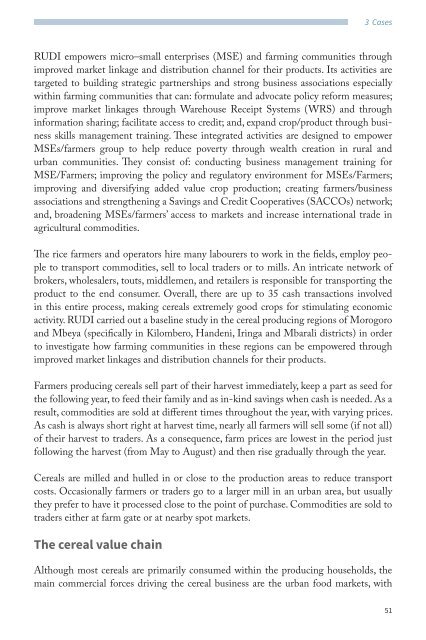Regional Markets
56ec00c44c641_local-markets-book_complete_LR
56ec00c44c641_local-markets-book_complete_LR
You also want an ePaper? Increase the reach of your titles
YUMPU automatically turns print PDFs into web optimized ePapers that Google loves.
3 Cases<br />
RUDI empowers micro–small enterprises (MSE) and farming communities through<br />
improved market linkage and distribution channel for their products. Its activities are<br />
targeted to building strategic partnerships and strong business associations especially<br />
within farming communities that can: formulate and advocate policy reform measures;<br />
improve market linkages through Warehouse Receipt Systems (WRS) and through<br />
information sharing; facilitate access to credit; and, expand crop/product through business<br />
skills management training. These integrated activities are designed to empower<br />
MSEs/farmers group to help reduce poverty through wealth creation in rural and<br />
urban communities. They consist of: conducting business management training for<br />
MSE/Farmers; improving the policy and regulatory environment for MSEs/Farmers;<br />
improving and diversifying added value crop production; creating farmers/business<br />
associations and strengthening a Savings and Credit Cooperatives (SACCOs) network;<br />
and, broadening MSEs/farmers’ access to markets and increase international trade in<br />
agricultural commodities.<br />
The rice farmers and operators hire many labourers to work in the fields, employ people<br />
to transport commodities, sell to local traders or to mills. An intricate network of<br />
brokers, wholesalers, touts, middlemen, and retailers is responsible for transporting the<br />
product to the end consumer. Overall, there are up to 35 cash transactions involved<br />
in this entire process, making cereals extremely good crops for stimulating economic<br />
activity. RUDI carried out a baseline study in the cereal producing regions of Morogoro<br />
and Mbeya (specifically in Kilombero, Handeni, Iringa and Mbarali districts) in order<br />
to investigate how farming communities in these regions can be empowered through<br />
improved market linkages and distribution channels for their products.<br />
Farmers producing cereals sell part of their harvest immediately, keep a part as seed for<br />
the following year, to feed their family and as in-kind savings when cash is needed. As a<br />
result, commodities are sold at different times throughout the year, with varying prices.<br />
As cash is always short right at harvest time, nearly all farmers will sell some (if not all)<br />
of their harvest to traders. As a consequence, farm prices are lowest in the period just<br />
following the harvest (from May to August) and then rise gradually through the year.<br />
Cereals are milled and hulled in or close to the production areas to reduce transport<br />
costs. Occasionally farmers or traders go to a larger mill in an urban area, but usually<br />
they prefer to have it processed close to the point of purchase. Commodities are sold to<br />
traders either at farm gate or at nearby spot markets.<br />
The cereal value chain<br />
Although most cereals are primarily consumed within the producing households, the<br />
main commercial forces driving the cereal business are the urban food markets, with<br />
51


